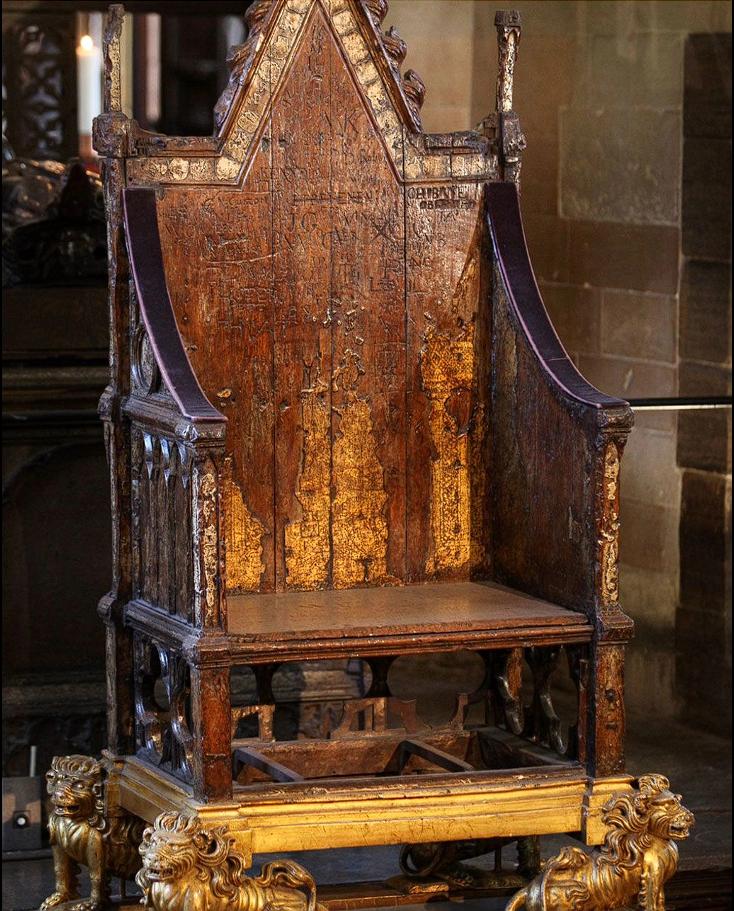St. Edward’s Chair, also known as the Coronation Chair, stands as a central and enduring symbol of British royal tradition. Commissioned in 1296, it has been the seat of nearly every English and British monarch’s coronation since 1308, making it one of the oldest pieces of furniture still in ceremonial use.
A Throne of History: Crafting the Coronation Chair
- Edward I’s Commission: A Symbol of Power:
- King Edward I commissioned the chair in 1296, intended to house the Stone of Scone, a powerful symbol of Scottish kingship.
- This act solidified English authority and incorporated Scottish royal tradition into the English coronation ceremony.
- The chair, was created, to hold a powerful artifact.
- Centuries of Use: A Royal Tradition:
- Since 1308, nearly every English and British monarch has been crowned while seated on St. Edward’s Chair, establishing a long-standing tradition.
- This continuous use underscores the chair’s significance in the continuity of the British monarchy.
- This tradition, has lasted for centuries.
- Ancient Craftsmanship: Enduring Significance:
- Despite the wear and tear of centuries, St. Edward’s Chair remains a testament to ancient craftsmanship and royal tradition.
- Its enduring presence in coronation ceremonies highlights its historical and symbolic importance.
- The chair, is a piece of history.
The Stone of Scone: A Symbol of Kingship
- Scottish Origins: A Royal Relic:
- The Stone of Scone, originally a symbol of Scottish kingship, was brought to England by Edward I and housed within St. Edward’s Chair.
- Its presence in the coronation ceremony reinforced the connection between the English and Scottish monarchies.
- The stone, is a powerful symbol.
- Return to Scotland: Temporary Coronation Journeys:
- The Stone of Scone was returned to Scotland in 1996, but it makes a temporary journey back to Westminster Abbey for each coronation ceremony.
- This tradition preserves the chair’s historic function and the symbolic connection between the stone and the monarchy.
- The stone, returns, for each coronation.
- Westminster Abbey: A Royal Setting:
- St. Edward’s Chair remains housed in Westminster Abbey, the traditional site of British coronations.
- The abbey’s historical significance and architectural grandeur enhance the chair’s symbolic power.
- The Abbey, is the perfect setting, for the chair.
A Symbol of Continuity: Enduring Royal Rituals
- Continuity and Authority: Royal Symbolism:
- St. Edward’s Chair represents continuity, authority, and the enduring rituals of the British monarchy.
- Its presence in coronation ceremonies reinforces the legitimacy and tradition of the crown.
- The chair, represents the power, of the crown.
- Worn Decoration: A Testament to History:
- Though once richly gilded and painted, centuries of use have worn away much of its original decoration, adding to its historical character.
- The chair’s aged appearance serves as a tangible link to the past, connecting modern monarchs to their predecessors.
- The wear, on the chair, tells a story.
- Modern Significance: Preserving Tradition:
- Today, St. Edward’s Chair continues its role as a vital component of British coronation ceremonies, preserving ancient traditions for future generations.
- Its continued use ensures that the rituals of the monarchy remain unbroken, connecting the past with the present.
- The chair, is still very important, to the royal family.
St. Edward’s Chair stands as a powerful symbol of British royal tradition, connecting the past with the present through its enduring presence in coronation ceremonies. Its history and significance continue to captivate and inspire, ensuring its place in the annals of royal history.

CÁC TIN KHÁC
Mary Walton: The Forgotten Inventor Who Helped Clean Up America’s Cities
Tomb of Queen Nefertari in the Valley of the Queens, Egypt
Discover the Hypostyle Hall of the Temple of Hathor at Dendera
Venus de Losange: Unveiling the Mystery of a 20,000-Year-Old Paleolithic Icon